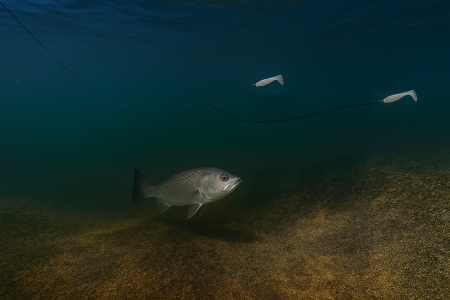mmontelongo
Creator
So I have been working with some different lures and I wanted to share some of the things I have learned from a number of youtube channels, experience, and fishing professionals.
Let’s talk about how we trigger the bite — not just if the fish eats, but why they eat.
When you’re throwing a jerk shad, especially with soft, deliberate twitches and pauses, you’re not just imitating a wounded baitfish — you’re selling an easy kill. Every gentle jerk sends a small pulse of vibration through the water. That’s enough to get a trout’s attention from the bottom or off to the side. But here’s the real kicker: the slow fall gives that speckled trout the time it needs to see, identify, and commit.

Contrast that with a paddle tail — a great search bait, no doubt. But it has to stay moving to kick and vibrate. That means it gives off constant stimulus but also moves through the strike window fast. A trout has to make a snap decision — "Is this prey worth burning energy to chase?" If not, the bait's gone.

This is where speck rigs shine. You're throwing two paddle tails, both vibrating, both drawing attention. The first lure might trigger interest, but by the time the trout locks on, it’s already past them. Then comes the second lure, just behind, still fluttering. Boom — that’s the opportunity. The trout, already engaged, sees a second target and strikes the slower option.

It’s like watching one deer take off and then seeing a second one hesitate — a predator goes for the straggler. The same logic applies here.
Next time you're out and want to maximize your odds, consider this:
Tight lines, y’all. May your bait fall slow and your strikes come hard.
Let’s talk about how we trigger the bite — not just if the fish eats, but why they eat.
When you’re throwing a jerk shad, especially with soft, deliberate twitches and pauses, you’re not just imitating a wounded baitfish — you’re selling an easy kill. Every gentle jerk sends a small pulse of vibration through the water. That’s enough to get a trout’s attention from the bottom or off to the side. But here’s the real kicker: the slow fall gives that speckled trout the time it needs to see, identify, and commit.
Contrast that with a paddle tail — a great search bait, no doubt. But it has to stay moving to kick and vibrate. That means it gives off constant stimulus but also moves through the strike window fast. A trout has to make a snap decision — "Is this prey worth burning energy to chase?" If not, the bait's gone.
This is where speck rigs shine. You're throwing two paddle tails, both vibrating, both drawing attention. The first lure might trigger interest, but by the time the trout locks on, it’s already past them. Then comes the second lure, just behind, still fluttering. Boom — that’s the opportunity. The trout, already engaged, sees a second target and strikes the slower option.
It’s like watching one deer take off and then seeing a second one hesitate — a predator goes for the straggler. The same logic applies here.
Next time you're out and want to maximize your odds, consider this:
- Use your jerk shad with intentional pauses — sell the easy target.
- Fish your paddle tails like searchlights — they draw eyes.
- Speck rigs? They create a second-chance scenario — and trout love an easy second chance.
Tight lines, y’all. May your bait fall slow and your strikes come hard.

